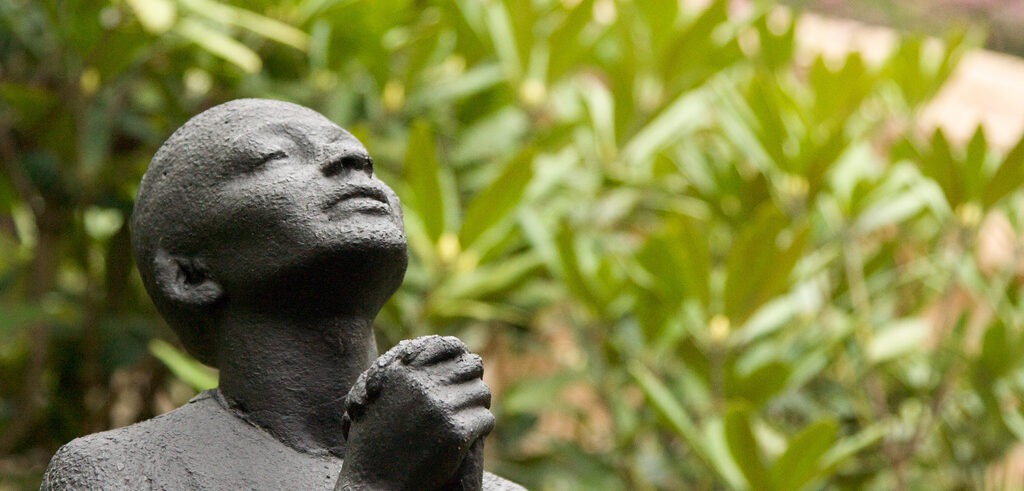It happened too often. “Where are the prayers?” the assisting minister would ask as we got ready for worship. “Oh no, I forgot to print them out. Hold on a minute, I’ll get them.” Racing to the computer, I link to our denominational publisher’s website to download the prayers for the Sunday. I make a few edits so that the congregation can speak the names of the sick, or I add the latest natural disaster or war, maybe the name of a leader that’s been in the news. Fortunately, the petitions are already shaped by the lectionary lessons for the day, so mostly we sound like we worked at making the prayers appropriate for the day.
I also worked once in an institution that had a tradition of using a “pastoral prayer,” in which the leading pastor spoke a long summary prayer of all the needs in the world and community. I noticed it was often the same experience. The prayers were considered at the last minute and sometimes the prayer ended up being a rambling, spontaneous mess. Like a plane circling the airport, it was sometimes hard to get that baby to the ground.
In my current call with multiple pastors, the preaching minister is tasked with writing the prayers of intercession. It has led me to consider some new connections between preaching and prayer. Rather than print off some previously written intercessions, I try to use the language and metaphor of the sermon to shape each prayer petition. In fact, the prayers have become a way to think more concretely about how the message of the sermon impacts the world. If I’m going to pray the sermon to God, to rework it into the language of lament or praise, petition or confession, for what exactly would we pray?
If standard petitions include petitions for the church, creation, the nations and leaders, the suffering, the local assembly, and even a remembrance of the saints, it becomes a test for me to see how the sermon addresses each of those worlds.
For example, did the sermon say anything about creation? Were there implications for lakes and waters, beasts and bugs? Did it address the issues that we face every day in living with or against God’s good creation? Were we called to be stewards, or have we listened to the buzz of bees or the roar of the lion as voices that shape our proclamation?
Of course, not every sermon can address every topic that we need to lift up in prayer. Can the assembly, however, easily draw implications from the sermon into their own prayer life? Are we left with issues that we can lift to God, or are we captured by the wonder of God’s goodness so profoundly that we cannot help speaking our praise?
Does the sermon open doors that our prayer life might explore? In many ways, the prayers become a testing ground to see if our sermon has relevance that truly lives in the assembly’s heart.
I wonder, too, if it can work the other way. Can the prayers of the people give guidance to our sermon preparation? We have a Monday morning Bible study at our church, made up mostly of senior members of the church. Before we read the texts for the upcoming Sunday, I ask, “What do we need to pray for today?” They list the names of family members or friends. They name the stories from the morning newspaper that trouble them. They talk about what’s happening in the church. They even comment on politics, and are surprisingly vulnerable about their own doubts or struggles.
Their prayers often shape what we hear in the appointed texts for the week. Often we even see connections with the text that are more relevant to their real lives than we would have had we not spent time talking about our prayers first. These Monday Bible study conversations make me wonder how it would look to gather members of our assemblies early in the week, before we begin to study and write.
What if we asked our communities what prayers we need to say for the church, the world, the hungry, one another, and anything else that keeps them awake at night. Would it bring a sharper focus to our proclamation? Would it guide us to draw more direct lines between the world of the sermon and the world in which our people live? Would they provide us with illustrations that really come alive or open up insights that we would not have come to on our own?
In my previous call, before I preached, I went to the sanctuary and walked around the room. I imagined who sat in which pew. Of course, they all sat in the same place every week so it was easy. I wondered what they were praying for; what they might pray out loud and what they would never dare say. Their lives shaped how I wrote a sermon. I wish I would have taken the next step to wonder how the sermon that I had just written could form intercessions, wide enough to bring the gospel to the world and their lives to God.
Bradley Schmeling’s bimonthly Working Preacher column, “Designing the Mystery,” looks at how to plan worship and preaching that is in step with the liturgy.

